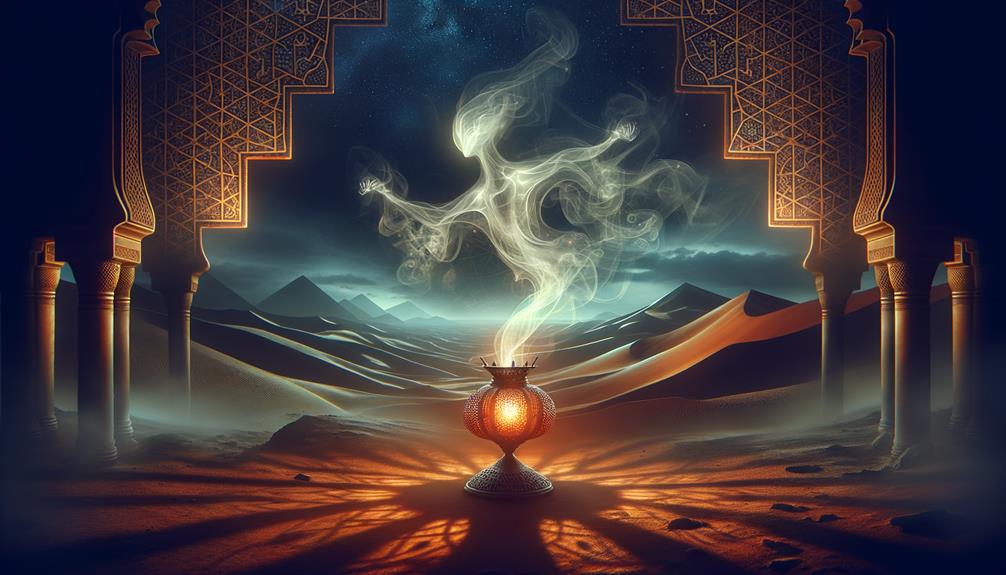In our modern world of quantum physics and cutting-edge tech, the concept of beings made of smokeless fire from ancient Islamic tales might appear out of place. Yet, I find myself looking at the similarities and differences between the Jinn, a supernatural entity from Islamic stories, and similar beings in other cultural folklore. Islamic tradition tells us that the Jinn are formed from a smokeless, burning fire and can change shape, interfere in human lives, and even have children. Oddly enough, these mysterious spirits are considered less powerful than angels, but they have the bold capability to occupy human bodies. As we delve into the mythology of the Jinn, we unravel the symbolism and cultural importance that have enabled their story to endure and evolve over the centuries. Stay tuned, as there's much more to these unseen entities than you might initially think.
Origins of Jinn Mythology

Digging into the roots of Jinn mythology, you'll find it quite interesting that these beings originate from pre-Islamic Arabian folklore. They later became a vital part of Islamic culture, representing a unique blend of various pagan beliefs and traditions. According to Islamic teachings, jinn are supernatural beings, created by Allah from a smokeless fire. Although invisible, they are a significant part of our world, indicating the belief in jinn in Islamic tradition.
Before the arrival of Islam, the idea of jinn was already well-known in Arabia. The jinn were seen as beings that were both worshipped and feared, thought to have supernatural powers, and believed to form societies similar to ours. When Islam came into being, it didn't reject these beings. On the contrary, it adapted the understanding of jinn, incorporating their existence into its theological structure.
As a result, jinn were not merely a continuation of pagan beliefs. Instead, they served as a way to harmonize these beliefs with the monotheistic principles of Islam. The jinn in Islamic culture evolved to become more than just supernatural beings. They started being seen as a reflection of divine power and a testament to the unseen realities that Islam recognizes.
Types and Characteristics of Jinn
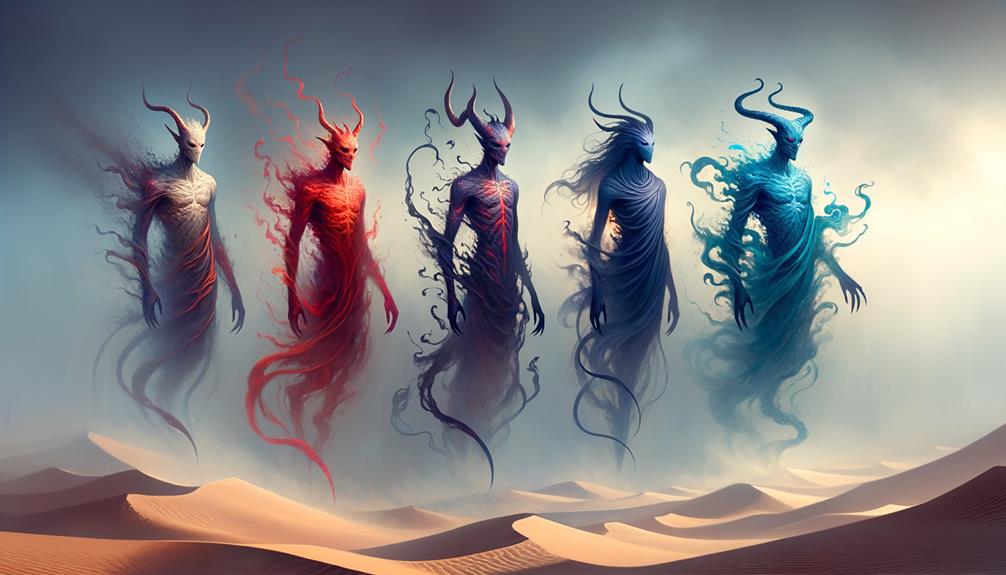
Let's dive into the world of jinn from the perspective of Islamic culture. It's quite interesting to note the different kinds and traits they possess, which give us insight into their role in this belief system. The Quran references jinn 104 times, portraying them as unique entities, not quite human, not quite angel. They're shape-shifters, often choosing to take the form of animals or humans.
Their ability to morph into different forms is a key part of their identity, hinting at their subtle and elusive nature. Much like us humans, jinn have their own societies, living in tribes, which is a nod to the social setup of pre-Islamic Arabia.
Jinn are not just one-dimensional – they have a range of moral attributes, from good to evil. This quality, the capacity for both kindness and wickedness, brings them closer to human nature, making them more relatable than angels. Their supernatural powers, like granting wishes or influencing human actions, make them fascinating and mysterious.
Keep in mind, though, that this is a cultural belief and the interpretation of jinn can vary based on personal beliefs and regional traditions.
Jinn in Islamic Literature
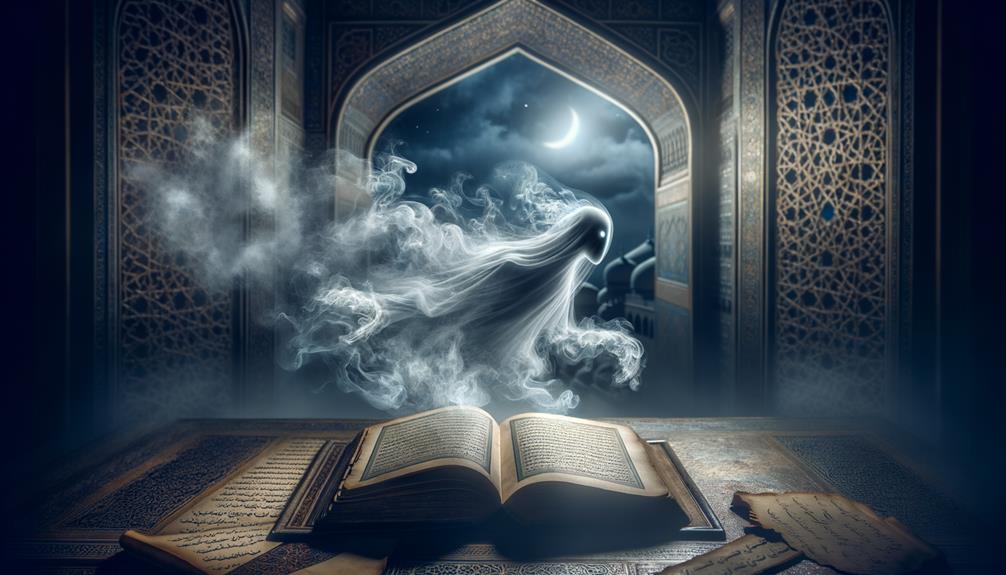
Curious about how jinn are depicted in Islamic literature, and what their roles reveal about cultural and religious beliefs? It's fascinating to learn that within this context, jinn are envisioned as unseen creatures, crafted from a smokeless fire by Allah. They coexist with humans in their own jinn societies, and, much like us, are subject to Allah's judgement.
The Quran features a segment called Al-Jinn, where we encounter a kind of jinn that adopted Islam. This illustrates the intriguing concept that jinn, similar to humans, can choose to be believers or non-believers. This adds a layer of complexity and depth to the portrayal of jinn in Islamic texts.
Here's a comparison of the different types of jinn:
| Type of Jinn | Characteristics | Islamic Texts |
|---|---|---|
| Believers | Accepts Islam | Quran's Al-Jinn |
| Non-believers | Rejects Islam | Hadith literature |
| Shape-shifters | Can change form | Folklore |
| Harmful | Causes harm | Sorcery texts |
This comparison showcases the diverse representations of jinn in Islamic literature, each reflecting unique cultural and religious beliefs. The ability of jinn to both believe and disbelieve underscores the importance placed on moral choice within Islamic theology.
Cultural Interpretations of Jinn
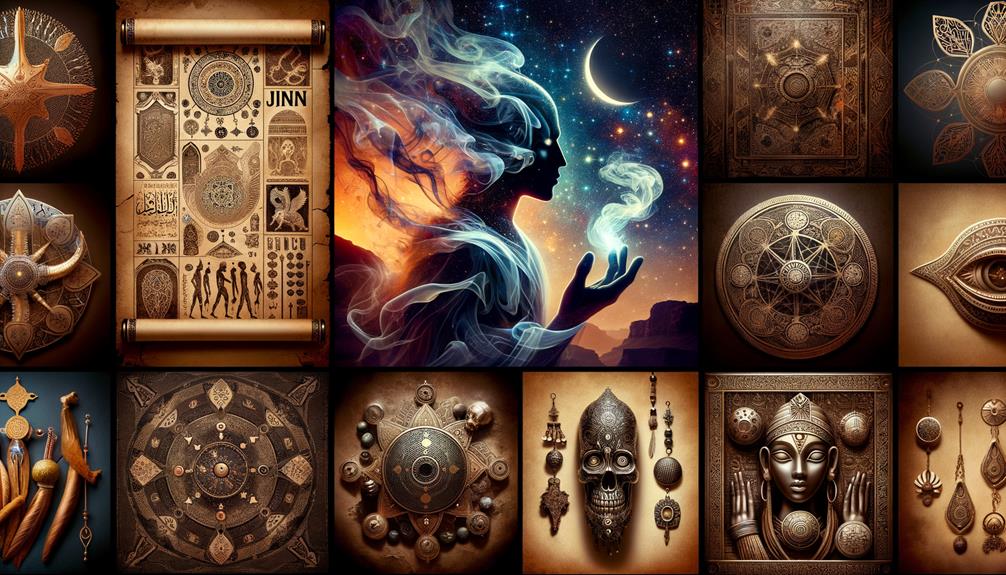
Taking a closer look at how different cultures perceive jinn, we find an array of interpretations for these extraordinary creatures. They can exist in both seen and unseen worlds, which makes them unique and fascinating. The way they're viewed can change drastically, depending on the culture, religion, or piece of literature you're considering. Jinn can be either friendly or hostile forces, making their mythological profile quite complex and intriguing.
In the Islamic belief, jinn are mentioned in the Quran. They're considered somewhat inferior to angels, yet they possess the potential for both good and evil, much like angels do. The Quran refers to jinn as part of the unseen, or al-ghaib, which is a world that's beyond our human understanding. This concept aligns with the idea of jinn as creatures that live in both the human world and the world of the jinn.
Different cultures have portrayed jinn in various ways. One of the most well-known depictions of jinn is in the classic tale of One Thousand and One Nights. In this story, jinn can be either good or evil, and this duality is a crucial part of their character. The King of the Jinn is shown as a powerful being, much like the jinn we see in Disney's Aladdin. However, this king also represents the belief in evil jinn, showing the broad range of interpretations across different cultures. This exploration of cultural views on jinn highlights the ongoing interest in these creatures and their continued presence in our collective thoughts.
Jinn Influence in Modern Media
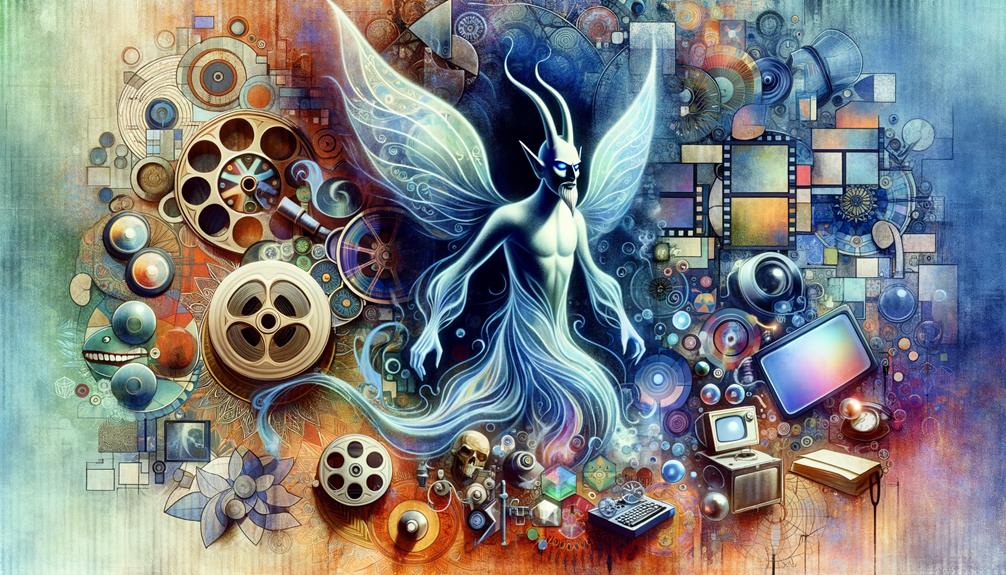
In today's media, you can't miss the impact of jinn, even though they're often portrayed inaccurately as genies. This comes from a misunderstanding of their intricate personality traits. In Islamic folklore, jinn are intelligent creatures and spiritual beings, often shown as unseen beings teetering between good and evil.
These beings, known as jinn, have made appearances in mainstream culture, such as Disney's Aladdin and Netflix's series Jinn. Unfortunately, these representations regularly promote stereotypes and incorrect beliefs about the mythological nature of jinn.
| Media | Jinn Portrayal | Impact |
|---|---|---|
| Disney's Aladdin | Jinn as a genie | Fuels misunderstandings |
| Netflix's Jinn | Jinn as evil spirits | Causes disputes |
| One Thousand and One Nights | Jinn in folk tales | Enriches folklore and mythology |
Historical stories often portray jinn as divine angels that Iblis refused to bow to the Islamic Prophet. Contrarily, some stories show them as obedient to King Solomon. These varied images of jinn in today's media highlight their intricate and mysterious personality traits, captivating audiences and ensuring their spot in modern storytelling, perpetuating the influence of jinn in today's media.
Frequently Asked Questions
What Does the Jinn Symbolize?
From what I gather, Jinns are a fascinating part of Islamic culture, representing things beyond our immediate perception. They're thought to live in a world just like ours, showcasing the eternal battle between right and wrong. Plus, they serve as a warning against the practice of worshiping idols.
What Is the Origin of the Djinn?
So, where exactly do Djinns come from? Well, the story is a bit tangled. We can trace their roots back to pre-Islamic Arabian religion, but they also appear in Islamic beliefs that came later. The term 'Djinn' itself is a bit of a puzzle. It might be linked to a mix of old pagan beliefs. The whole thing is fascinating, isn't it?
What Are the Three Types of Jinn in Islam?
Within the context of Islam, there exist three distinct types of jinn. These are the Djinn, Ifrit, and Marid. The Djinn are known to be rather common and have the intriguing ability to change their shape at will. On the other hand, the Ifrit are renowned for their formidable power, coupled with a fiery aspect. Lastly, the Marid are closely tied to water and are reputed for possessing profound magical knowledge.
How Long Do Djinn Live?
You may be wondering, "Just how long can a Djinn live?" Well, based on a variety of sources, it's widely accepted that Djinns can live for hundreds, if not thousands, of years. This is primarily due to their unique smokeless fire composition, a mystical aspect that lends them longevity. This extended lifespan is often why we see them depicted as ageless, mysterious entities in numerous stories and tales.

